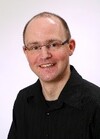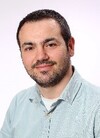About Stefan Welzel
 Dr Stefan Welzel is team leader of the Solar Fuels – Facility and Instrumentation (SFFI) group at the Dutch Institute For Fundamental Energy Research (DIFFER). He holds a PhD (2009) in physics from the Ernst-Moritz-Arndt University in Greifswald (Germany) and has a background in plasma physics and plasma diagnostics. The PhD project at the Leibniz-Institute for Low Temperate Plasma Physics (INP) Greifswald (2005-2009) was focusing on infrared laser-based spectroscopy for different sensing applications such as molecular plasmas or breath gas analysis. From 2009-2013 Stefan worked as a postdoc in the Plasma and Materials Processing group (PMP) at the Eindhoven University of Technology and joined DIFFER as a postdoc in 2013. The research focus was on the chemistry of e.g. air-, nitrogen- or carbon dioxide-containing gas discharges. In 2015 he became facility manager of the evolving Solar Fuels theme at DIFFER which involves taking care of the required lab infrastructure for the research groups. In addition the SFFI team is involved in the realization of setups and reactors, modifications thereof and prototype development derived from the research results. He is currently involved in European, nationally and industrially funded projects that are trying to combine gas discharges with electrochemical conversion routes.
Dr Stefan Welzel is team leader of the Solar Fuels – Facility and Instrumentation (SFFI) group at the Dutch Institute For Fundamental Energy Research (DIFFER). He holds a PhD (2009) in physics from the Ernst-Moritz-Arndt University in Greifswald (Germany) and has a background in plasma physics and plasma diagnostics. The PhD project at the Leibniz-Institute for Low Temperate Plasma Physics (INP) Greifswald (2005-2009) was focusing on infrared laser-based spectroscopy for different sensing applications such as molecular plasmas or breath gas analysis. From 2009-2013 Stefan worked as a postdoc in the Plasma and Materials Processing group (PMP) at the Eindhoven University of Technology and joined DIFFER as a postdoc in 2013. The research focus was on the chemistry of e.g. air-, nitrogen- or carbon dioxide-containing gas discharges. In 2015 he became facility manager of the evolving Solar Fuels theme at DIFFER which involves taking care of the required lab infrastructure for the research groups. In addition the SFFI team is involved in the realization of setups and reactors, modifications thereof and prototype development derived from the research results. He is currently involved in European, nationally and industrially funded projects that are trying to combine gas discharges with electrochemical conversion routes.
About Michail Tsampas
 Dr Michail (Mihalis) Tsampas is senior scientist and group leader at the Dutch Institute For Fundamental Energy Research (DIFFER) since 2014. He holds a PhD (2010) in chemical engineering from the University of Patras (Greece) and has a background in catalysis and electrochemistry. After the completion of his PhD he worked at IRCELYON (France) on environmental catalysis and electrochemical promotion (2011-2014) His current research is focused on the area of electrochemical membrane reactors for energy storage and conversion applications. His group employs various types of polymeric and ceramic ion exchange conductors that allow coupling renewable energy-driven processes to wide range of applications such as oxygen separation, water electrolysis, electro-fixation of nitrogen and carbon dioxide. Apart from conventional materials synthesis methods, nanostructuring pathways are employed either for increasing the active surface area of electrocatalysts or for enabling atomic level control of the exposed sites. Group activities also involve the development of light or plasma assisted electrochemical routes for overcoming inherent material or process limitations. He is/was involved as principal investigator, coordinator or co-applicant in 20 research programs financially supported by Dutch and European funding entities as well as industrial partners.
Dr Michail (Mihalis) Tsampas is senior scientist and group leader at the Dutch Institute For Fundamental Energy Research (DIFFER) since 2014. He holds a PhD (2010) in chemical engineering from the University of Patras (Greece) and has a background in catalysis and electrochemistry. After the completion of his PhD he worked at IRCELYON (France) on environmental catalysis and electrochemical promotion (2011-2014) His current research is focused on the area of electrochemical membrane reactors for energy storage and conversion applications. His group employs various types of polymeric and ceramic ion exchange conductors that allow coupling renewable energy-driven processes to wide range of applications such as oxygen separation, water electrolysis, electro-fixation of nitrogen and carbon dioxide. Apart from conventional materials synthesis methods, nanostructuring pathways are employed either for increasing the active surface area of electrocatalysts or for enabling atomic level control of the exposed sites. Group activities also involve the development of light or plasma assisted electrochemical routes for overcoming inherent material or process limitations. He is/was involved as principal investigator, coordinator or co-applicant in 20 research programs financially supported by Dutch and European funding entities as well as industrial partners.
Role in the project: members of DIFFER, project coordinator
1-As project coordinator, DIFFER has both a scientific as well as a management role within KEROGREEN. You are both more responsible for the research part, right? What are your specific tasks?
Stefan: KEROGREEN is based on several process steps (as nicely depicted on the project website) in order to convert carbon dioxide and water to kerosene. DIFFER’s scientific focus is on the starting point of the process chain i.e. the conversion of carbon dioxide (CO2) into carbon monoxide (CO) via plasmolysis. This process step leaves an oxygen containing mixture of CO2/CO which needs further upgrading by (i) separation of the oxygen followed (ii) by the purification of the CO. Mihalis is the leader of the entire DIFFER workpackage which covers both the plasmolysis process and in parts the development of the oxygen separation process. Mihalis investigated the plasma integration with oxygen ion conducting electrochemical reactors as a way to upgrade plasmolysis effluent. My efforts were concentrated on how to translate scientific findings of the plasmolysis process into the engineering of a plug and play device as the first part of the process chain.
2-The project comes now to its end. What are the main results achieved so far by DIFFER?
Mihalis: During the first part of the project DIFFER activities were focusing on the understanding of the carbon dioxide (CO2) plasmolysis at a fundamental level experimentally and theoretically. In parallel, the group of Suleyman Er was developing (i.e. calculating) a digital library of perovskite materials that might suitable for electrochemical processes. In the frame of KEROGREEN the target was the oxygen removal capability of the materials.
The groups of Richard van de Sanden and Paola Diomede were involved to perform experiments on a typical lab-type reactor, the modeling of the plasmolysis process, and benchmarking of the model against the experimental results. Exactly this combined approach led to much better understanding of a few essential “knobs” to tune the plasmolysis process.
Based on these studies, the focus during the second half of the project was clearly on the engineering side, i.e. on the scaling up of the plasmolysis lab-reactor. The probably even bigger challenge was the simultaneous development into a plug and play prototype as one of DIFFER’s hardware contributions to the consortium. The challenge was not only to make a functional module that does not require an operator to set the correct process conditions manually, but also to make it fit into the container sized demo plant at Karlsruhe Institute of Technology (KIT).
Carbon dioxide plasmolysis is a very efficient electrically-driven process but requires gas separation and recuperation because the produced carbon monoxide remains mixed with oxygen in the reactor outlet. In the frame of the project we were able to demonstrate the coupling of plasmolysis with solid oxide electrolysis cells (SOEC) as a renewable-electricity-driven route for oxygen separation at lab scale. Apart from upgrading the produced gas mixture, this coupled approach benefits from material stability. Durability tests showed better stability in coupled operation when compared with conventional carbon dioxide solid oxide electrolysis.
3-What are the next steps for DIFFER? Are you thinking on follow-up activities directly linked to your work within the project?
Stefan: The KEROGREEN plasmolysis reactor module embodies only a fraction of the ideas that have been developed theoretically to improve the efficiency. To a bigger extent the translation into hardware is also a material question e.g. due to the temperatures of several thousand degrees Celsius in the reactor. In view of the entire KEROGREEN process chain, recuperation aspects of the plasma effluent before and after oxygen separation need clearly more attention. In addition, the current progress in microwave technology will allow in a few years the replacement of the current hardware driver of the plasma process. We don’t want to reveal too many details, but some of these aspects are currently being translated into new project ideas at DIFFER.
The even more promising field seems to be the synergy between plasmolysis and electrolysis as it opens up novel routes for the electrically-driven production of valuable carbon- or nitrogen-based feedstock. Another European project (ORACLE) in which, among others, DIFFER and VITO are involved, is working on the nitrogen-route.
Since the oxygen separation after plasmolysis remains the crucial step for processes that start from CO2, we would like to continue on the coupled plasma solid oxide electrolysis cells operation based on the promising proof-of-concept on lab scale. There are two directions which will become equally important in the nearer future, the examination of novel electrode materials and the reconsideration of the high-temperature solid oxide electrolysis cells stack design. For KEROGREEN conventional fuel cell equipment has been re-used. We are convinced that improved stack design targeted on a high-temperature carbon-based process would ease the electrification of many processes in the chemical industry.
4-And which benefits do you see for DIFFER?
Mihalis: The engineering effort of developing a plasmolysis demo module added an extra piece to the list of DIFFER facilities. The fact of having this kind of module that is transportable, plug and play without the need for an advanced operator and capable of processing other feed gases or gas mixtures than CO2 will be an extra convincing argument for the consideration of plasma-based processes in Power-to-X applications over research-like reactors.
Last but not least, in the frame of oxygen separation, DIFFER was developing several test benches on different scale to characterize the electrochemical performance of individual cells and cell assemblies under different relevant gas conditions. The knowledge on the design of a functional shell around a (high-temperature) solid oxide electrolysis cells stack will be highly valuable in follow-up projects which should focus on the stack re-design as mentioned earlier.
5-How does your work contribute to the field of renewable-electricity-driven processes?
Stefan: Our work has added a new green pathway, i.e. the plasma coupled solid oxide electrolysis cells, to the library of emerging routes for recycling CO2 emissions towards CO2 neutral fuels and chemicals (Power-to-X).
6-What is your feeling about the overall project achievement? Which were the main challenging aspects?
Mihalis: Based on the boundary conditions and high-risk high-gain nature of the project the achievements are very impressive, not only in terms of scientific publications but also in view of the engineering part since many modules have been developed, some even from scratch, and are coupled to complete the KEROGREEN chain.
As for the social coherence of the consortium as well as the technical fine-tuning for the demo plant the COVID-19 period with lockdowns, different rules in different European countries, travel restrictions, low capacity of the partners and order delays turned out to be a real burden. As for the high-risk part, the entire consortium was facing the challenge to turn raw materials in form of powders (as provided by Cerpotech) into functional stack modules for oxygen separation with barely any support from commercial suppliers that could deal with the KEROGREEN process conditions. At the end a combined effort of DIFFER, HyGear and VITO on all the “unforeseen” aspects led to the realization of a functional oxygen separation stack module with a promising proof-of-concept on lab scale.
Many thanks for the interview. Wish you good luck for finalisation of the project tasks and still open challenges for the future!

